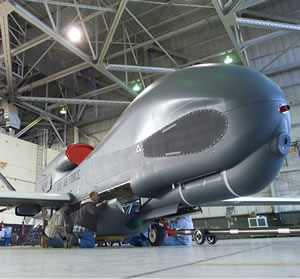
Few months after declaring the latest model Global Hawk intelligence, surveillance, reconnaissance (ISR) unmanned aircraft ‘operational’ the United States Air Force has announced it has decided to discontinue any further procurement of the Block 30 RQ-4 Global Hawk drones. Deputy Defense Secretary Ashton Carter cited increasing costs as a critical factor in the cancellation decision. Media reports indicate that the USAF will retire the Block 30 drones currently in the air fleet and all future production will be terminated.
Although cost was a key element in the cancellation decision, the RQ-4 had also not performed to expectations. Initially, the Global Hawk was seen as a viable replacement for the long-lived U-2 manned jet. Anticipated cost savings hoped to be realized in fielding the RQ-4 as a replacement for the U-2 never materialized. Northrop Grumman commented it was disappointed with the Pentagon’s decision, and plans to work with the Pentagon to assess alternatives to program termination, they added that extending the U-2’s service life also represents additional investment requirements for that program, which also places pilots in danger, has limited flight duration, and provides limited sensor capacity. The company also said continuing support for the Global Hawk Block 40 system, as well as for the Navy’s Broad Area Maritime Surveillance system demonstrate the importance of the Global Hawk platform.

The commander of Air Combat Command declared initial operational capability for the RQ-4 Block 30 Global Hawk on Aug. 10, 2011. At the time the Air Force said the drone was successfully deployed in support of Operation ODYSSEY DAWN in Libya and Operation TOMODACHI in Japan. The Block 30 is an advanced version of the Global Hawk, equipped the an improved sensor payload called ‘Enhanced Integrated Sensor Suite (EISS)’ combining electro-optical/infrared and synthetic aperture radar imaging capabilities, offering wider area coverage, particularly by the improved radar. The aircraft was also scheduled incorporate with an advanced Airborne Signals Intelligence Payload (ASIP) signals intelligence (SIGINT) payload.
Admiral Robert Willard, Commander, U.S. Pacific Command commented on the decision saying that the termination will not affect the availability or utility of Global hawk in Asia Pacific. “Decisions on whether to terminate a specific block of aircraft is generally determined by what is being incorporated in the specific block is serving our needs.” Willard said.
The Air Force had initially projected a purchase of 42 Block 30 Global Hawks in their 2011 budget proposal at an estimated cost of approximately $215 million per aircraft. The Defense Department commented that the future cost of the Block 30 aircraft, in a best case scenario, would be comparable to the U-2, but within the framework of the new five-year budget proposal the Block 30 would be significantly more costly to acquire and maintain than the existing manned U-2. Defense sources have indicated that the U-2 will in fact continue in operation and will be upgraded.
When the Global Hawk first began active service in 1998, much was expected of the aircraft and Air Force leaders expressed confidence the plane would outperform the U-2 while delivering some major cost savings. Over the years, while the RQ-4 did perform its mission reasonably well, acquisition and maintenance costs continued to grow and Air Force leaders never committed themselves to retiring the U-2. With the Block 30 Global Hawks now to be phased out of service, the 33 operational U-2’s will be called upon to serve as the Air Force’s ISR workhorse.
The U-2, affectionately known as the Dragon lady, has been in service since 1955. Throughout the years, the U-2 has been routinely rebuilt, upgraded, and modernized. In USAF service, the U-2 fleet has flown more than 95,000 hours since 2003.
Cancellation of the Block 30 buy will not immediately affect the planned acquisition of the Block 40 Global Hawk or the US Navy’s acquisition of the maritime variant called the Broad Area Maritime Surveillance (BAMS) system from Northrop Grumman. The Block 40 is equipped with the advanced Multi-Platform Radar Technology Insertion Program (MP-RTIP) capable of delivering photo-quality imagery while conducting ground surveillance.
NATO’s projected purchase of five redesigned Global Hawks equipped with MP-RTIP will not be affected by the USAF cancellation and Germany’s EuroHawk SIGINT program will also remain intact, although Berlin is planning to reduce its Euro Hawk buy from six to four aircraft.
News of the cancellation comes at an unfavorable time for Northrop Grumman as the company was just embarking on an intensive campaign to sell the Global Hawk in foreign markets. In late December 2011, South Korea decided to place its proposed acquisition of four Global Hawks on hold primarily as a result of Northrop Grumman and South Korean negotiators failure to reach an agreement on the final price of the aircraft. The originally quoted price of $379 million had risen to an estimated $800 million, an amount far beyond South Korea’s anticipated funding for the aircraft. Although the deal is not completely dead, the USAF cancellation may have a very detrimental influence on the South Korean government’s willingness to commit to the Global Hawk.
Northrop Grumman is naturally concerned that the USAF’s cancellation of the Block 30 drones may have an adverse influence on other foreign nations that previously expressed an interest in acquiring varying numbers of the Global Hawk. Australia and Japan have been giving the Global Hawk a very serious look as they strive to modernize and upgrade their own ISR capabilities. Only time will tell if the Block 30 drones will remain on any nation’s wish list.



















